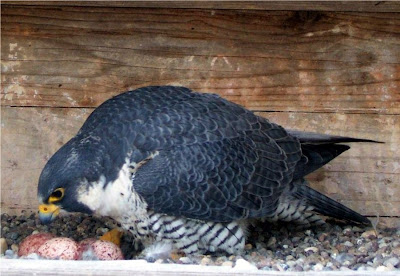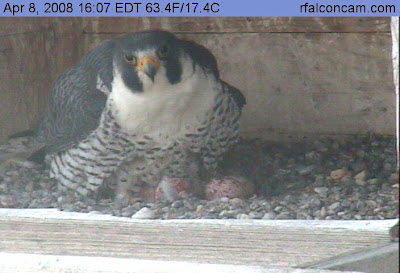Tuesday, April 8, 2008
Rome: waiting for eyases



Peregrines are Aria and vento.
I've watched them for quite a while and they where both fuzzing around with the eggs. Not turning, but checking. As you see in the pics. Looking down, touching, pushing it underneath the wings. Is something going on? It just might. Maybe one the eyas is making little screamy sounds. They start by doing that from within the egg. It is a way of comunicating with the parents, but formost with the brothers and sisters in the other eggs. It is a way of telling them, come on guys i'm working my way out, you do the same, you can do it!!
Labels:
Aria and Vento,
pellegrino,
peregrine falcon,
Rome
Zwolle




Let me introduce the falconcouple to you: The female was born on May 12 2005 in Hamm, Germany. She's banded left leg: broad white band K/6. She grew up in a nest of 4 sisters. A real sister act!The male was born on May 5 2005 in Dortmund, Germany . He's banded left leg: broad white band K/3. He was in the nest with 3 brothers.On April 23 2007 they where first seen in Zwolle, as a bonded couple. Since 2002 the nest was occupied by a Gyrfalcon who prevented any peregrine falcon from laying eggs in the nestbox. This clutch is her first ever. Females don't lay their first egg before their 4th year.
Zurich





 1996 klärt Orniplan im Auftrag der Fachstelle Naturschutz von Grün Stadt Zürich die Machbarkeit von Falken-Nisthilfen, speziell für den Wanderfalken ab und schlägt nach der Prüfung von ca. 12 Gebäuden zwei Standorte vor: den Hochkamin des Kehrichtheizkraftwerkes Josefstrasse und den Hochkamin des zweiten städtischen Werkes im Hagenholz. Im Dezember 1997 wurden die beiden Kästen montiert und seither alljährlich von Turm- oder Wanderfalken besetzt.
1996 klärt Orniplan im Auftrag der Fachstelle Naturschutz von Grün Stadt Zürich die Machbarkeit von Falken-Nisthilfen, speziell für den Wanderfalken ab und schlägt nach der Prüfung von ca. 12 Gebäuden zwei Standorte vor: den Hochkamin des Kehrichtheizkraftwerkes Josefstrasse und den Hochkamin des zweiten städtischen Werkes im Hagenholz. Im Dezember 1997 wurden die beiden Kästen montiert und seither alljährlich von Turm- oder Wanderfalken besetzt.The scrape has been used by this peregrine couple for 2 years now. In both years they fledged one juvenile. They are breeding again. It;'s going so fast it's almost impossible to catch. In the pics, the female is preening, walks towards the entrance. And all of a sudden the male comes out and is on the ledge. How many eggs are there. Would love to know!
Broodpatch
When incubation starts both peregrines take turns breeding.
The female peregrine, as well as the male develop a brood patch during the breeding season. Changes in hormone levels like prolactine, progesteron and estradiol during the nesting season start the process. These hormones start ro rise as soon as the second last egg has been layed. Down feathers on the bird's tummy, and even some contour feathers, suddenly get very loose. In the peregrine falcon those feathers just fall out. When the feathers fall out, tissue changes start to happen too. The tissue in the tummy area swells. The tissues hold more water, and more bloodvessels are starting to grow in that area. These changes make the bird's tummy skin almost as hot as the body's interior.
When the incubating peregrine sits on the eggs, the skin muscles open up the brood patch. Then the parent sits down and wiggles its body back and forth a bit. The sensitive skin feels for the eggs so the parent can settle where the skin makes best contact with the eggs. The parent keeps turning the eggs almost every hour. This is done to prevent the fast growing enebryo to stick to the shell and to take care the eggs are evenly warmed by the broodpatch!
For the parent peregrine the area of the broodpatch is a problem in their own thermoregulationsystem of the body. In order to keep it's own temperature on 104F they have to eat a lot, so there is a constant suply of energy.
The female peregrine, as well as the male develop a brood patch during the breeding season. Changes in hormone levels like prolactine, progesteron and estradiol during the nesting season start the process. These hormones start ro rise as soon as the second last egg has been layed. Down feathers on the bird's tummy, and even some contour feathers, suddenly get very loose. In the peregrine falcon those feathers just fall out. When the feathers fall out, tissue changes start to happen too. The tissue in the tummy area swells. The tissues hold more water, and more bloodvessels are starting to grow in that area. These changes make the bird's tummy skin almost as hot as the body's interior.
When the incubating peregrine sits on the eggs, the skin muscles open up the brood patch. Then the parent sits down and wiggles its body back and forth a bit. The sensitive skin feels for the eggs so the parent can settle where the skin makes best contact with the eggs. The parent keeps turning the eggs almost every hour. This is done to prevent the fast growing enebryo to stick to the shell and to take care the eggs are evenly warmed by the broodpatch!
For the parent peregrine the area of the broodpatch is a problem in their own thermoregulationsystem of the body. In order to keep it's own temperature on 104F they have to eat a lot, so there is a constant suply of energy.
Labels:
broodpatch,
Incubation,
peregrine falcon,
slechtvalken
Subscribe to:
Comments (Atom)















































